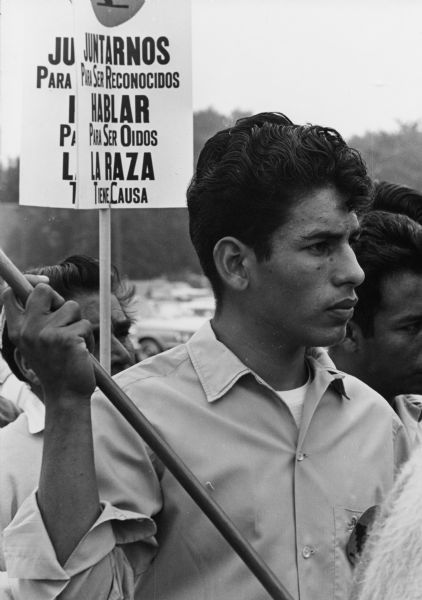| An Obreros Unidos (United Workers) member holding a sign, possibly like those in the background, that says "Juntarnos Para Ser Reconocidos/Hablar Para Ser Oidos/La Raza Tiene Causa" which translates to "Join To Be Recognized/Speak to Be Heard/The People Have A Cause." On August 15, 1966, 24 marchers left Wautoma, Wisconsin, headed west to Coloma, then south along State Highway 51 and reached the Capitol in Madison after five days and eighty miles of walking. Led by Jesús Salas, marchers went to state agencies to present the following demands: $1.25 minimum wage; better housing; insurance for accidents and hospitalization; public toilet facilities for farm worker use; and a meeting with the Governor's Committee on Migratory Labor. Obreros Unidos grew in Wisconsin during the 1960s and had deep roots in South Texas and Mexico. It was formed to deal with discrimination and oppression migrant farm workers were facing while working and living in Wisconsin and elsewhere along the journey to the North. In 1946, more than 4,000 farmworkers from Texas migrated to Wisconsin to cultivate and harvest vegetable and fruit crops. In 1961,85 percent of about 18,000 migrant workers, including 5,000 children under age 16, were recruited from Texas to work in Wisconsin. Obreros Unidos marchan hacia Madison Un miembro de Obreros Unidos sosteniendo un letrero, posiblemente uno como otros en el fondo, que dice "Juntarnos Para Ser Reconocidos/Hablar Para Ser Oídos/La Raza Tiene Causa" y se traduce a "Join To Be Recognized/Speak to Be Heard/The People Have A Cause" en inglés. El 15 de agosto de 1966, 24 manifestantes se fueron de Wautoma, Wisconsin, siguiendo al oeste hacia Coloma, luego al sur a lo largo de la carretera estatal State Highway 51, y llegaron al Capitolio en Madison después de cinco días y ochenta millas caminando. Dirigidos por Jesús Salas, los manifestantes visitaron agencias estatales para presentar las siguientes demandas: un sueldo mínimo de $1.25 por hora; mejores viviendas; seguro de accidentes y hospitalización; baños públicos para uso de los trabajadores; y una junta con el Governor's Committee on Migratory Labor (comité del gobernador que trata con la fuerza laboral migratoria). Obreros Unidos se desarrollo en Wisconsin durante los años 1960 y tenía raíces profundas en el sur de Texas y México. Fue fundado para combatir la discriminación y opresión que los trabajadores agrícolas emigrantes estaban sufriendo mientras trabajaban y vivían en Wisconsin y en otros lugares a lo largo de su viaje al norte. En 1946, más de 4,000 trabajadores agrícolas de Texas emigraron hacia Wisconsin para cultivar y cosechar vegetales y fruta. En 1961, 85 por ciento de aproximadamente 18,000 trabajadores emigrantes, incluyendo 5,000 niños menores de 16 años, fueron reclutados de Texas para trabajar en Wisconsin. |

